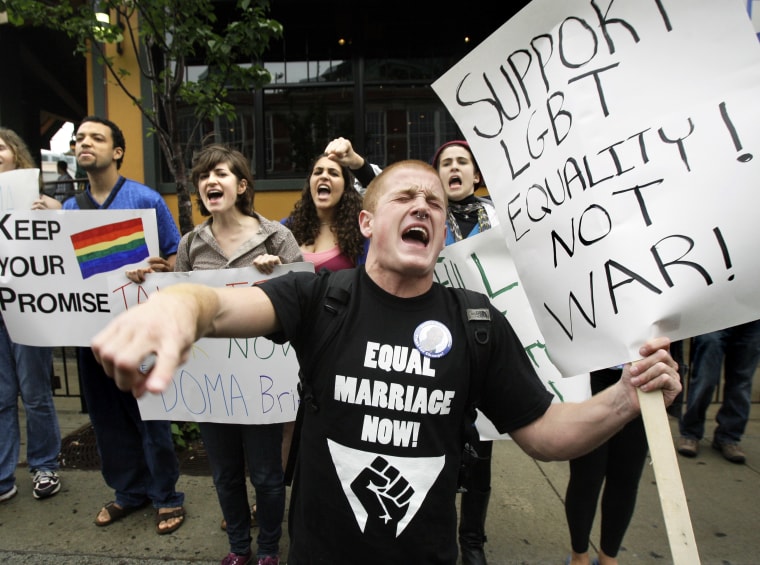With two marriage equality cases being argued at the U.S. Supreme Court Tuesday and Wednesday, attorney David Boies expressed his deep faith in the U.S. justice system—he said that if you put the opponents of marriage equality under oath on the stand, and made them give direct answers to direct questions about their arguments for injustice, their logical house of cards would collapse.
If only social change worked that way. On one level, Boies is absolutely right as the decision in California's Prop 8 case, now under consideration before the Supreme Court, was a clear victory. But it took years of work to bring us to the day when right and logic could triumph over prejudice, ignorance, and fear in that court.
In 1996, two different events set processes in motion that helped to bring us to the remarkable showdown inside and outside the Supreme Court this week. On September 21st, President Bill Clinton signed the Defense of Marriage Act (DOMA), the centerpiece of this week’s arguments. And that spring, students at the University of Virginia marked the first Day of Silence, a day of non-violent protest of the silencing effect of anti-LGBT violence and bias.
Seventeen years later, the movement for LGBT equality and marriage rights for same-sex couples has built toward direct challenges to DOMA with state-by-state legislative battles, years of work in the court of public opinion, and the critical building blocks of numerous court cases. There are many heroes in that movement, and many amazing organizations that have pushed the cause forward.
The Human Rights Campaign, Freedom to Marry, American Foundation for Equal Rights, ACLU, statewide member organizations of the Equality Federation, Lambda Legal, National Center for Lesbian Rights and countless other local, state and national organizations have led us to this moment.
Alongside these champions, however, another movement was growing. When we write the history of how we finally achieved marriage equality, I hope we remember the other, often forgotten heroes of this moment.
Many of them can’t vote. Many of them aren’t even old enough to drive. And far too many of them have been rejected by family and friends because of who they are.
But there is no doubt we are where we are today as a society—where the majority of us believe in marriage equality and the Supreme Court may strike down two laws written to deliberately discriminate against American citizens—in large part because of youth.
Just ask Senator Rob Portman of Ohio.
Conventional wisdom, especially as Tea Party candidates continually challenge incumbent Republicans from the right, is that a Republican senator would throw away his or her seat by coming out in favor of marriage equality.
What led Senator Portman to announce his support for marriage equality earlier this month? His college-age son.
Will Portman came out to his parents two years ago. After some soul searching, Senator Portman realized his position on marriage equality was wrong.
It was a startling reminder of how profound aspects of the change we’re seeing around marriage equality originated with the actions of youth and young adults.
An incredible 81% of 18-29 year olds support marriage equality, according to a Washington Post-ABC News poll released last week. Young voters clearly are becoming a more powerful voting bloc, and they are unwavering in their support on this issue.
Like Senator Portman, most younger Americans today know an out LGBT person, often a peer. Suddenly, much of the nonsense their peers may have heard about LGBT people doesn’t seem to fit. It turns out the student next to them is not all that different, even if they love someone of the same sex.
LGBT middle and high school students still face severe and routine bullying, harassment and even assault. More than 4 out of 5 LGBT students said they’d been harassed in the past year because of their sexual orientation, and more than 1 in 5 faced physical assault in school, according to GLSEN’s 2011 National School Climate Survey. Yet these youth are brave and resilient and continue to come out.
Out students have greater self-esteem, lower levels of depression and a greater sense of school belonging. They also want to take action to change their schools and the world for the better.
In 2000, the creators of the Day of Silence asked my organization, GLSEN, to take over national coordination of the event and help it spread nationwide. Today, the event is one of the largest youth-led days of action for any issue, engaging hundreds of thousands of students in a non-violent, silent call for equality, justice and respect for all people, regardless of their sexual orientation, gender expression, or gender identity.
On April 19, students from across the country will once again mobilize for GLSEN's Day of Silence. The youth advocates will take a vow of silence to raise awareness about anti-LGBT bullying and discrimination.
In doing so, they will symbolically represent the silencing effect LGBT youth still experience today. At the same time, they will add to a legacy of great bravery that has created visibility and helped to build the 81 percent.
